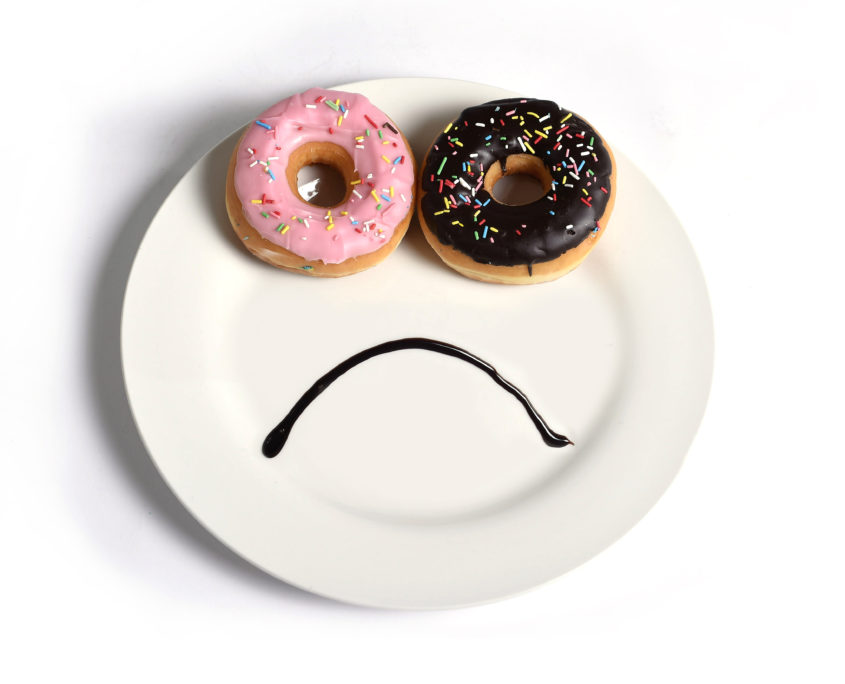Best Way to Cut Fat: 6 Simple Tips

You might think that you know the best way to cut fat, but do you? It might surprise you that there’s more to cutting fat than cutting calories. And you don’t have to run a marathon to cut fat, either. (Although, when you eat SANE foods, you’ll probably feel like running a marathon!) But the best way to cut fat is to get SANE about your food and activity levels. These six tips will help you learn how to cut fat naturally and easily and keep it off for the long term. Discover what you’ve been missing to start life-long fat-burning.
1. Influencing your hormones to find the best way to cut fat and lose weight
Diet quality controls hormones. That’s why learning how to eat real, nutritious food is the best way to cut fat. Calorie quality means that your food choices support your hormones. In turn, your hormones will support you and cut out unnecessary fat. Quality calories do several things:
- They fill you up.
- Provide sustained energy.
- They keep your body from converting food into fat.
- Trigger fat-burning hormones.
What hormones affect weight?
Your body produces many hormones, but a few select ones help the most in fighting the fat for weight loss. Here are the top fat-cutting hormones and what they do.
- Ghrelin is released by the stomach and increases hunger. It’s known as the “hunger” hormone.
- Glucagon-like peptide 1 is produced in the gut. Released in response to food, it reduces appetite and decreases the release of insulin.
- Leptin is produced by fat cells. It signals that you’ve eaten enough based on fat stores and decreases your appetite.
- Pancreatic polypeptide (PP) is another hormone that acts as a satiety hormone. It suppresses pancreatic secretions to help you feel fuller faster.
- PYY is one more satiety hormone. It’s released into the bloodstream before the food arrives in the lower small intestine and colon to let you know you’re full.
How are hormones balanced in the fight against fat?
Your body, when fed nutrient-dense food, automatically balances your hormones through your setpoint.
What is the set point? Your setpoint weight determines the weight your body thinks it should be. It’s the weight your body strives to maintain within a specific range. When you need to lose weight, your setpoint handles it without any help from you. The problem enters when your setpoint has been altered by inSANE foods without quality calories.
The good news is that you can alter your setpoint weight. Eating nutrient-dense foods feeds your body, increasing the satiety hormones and decreasing the hunger hormones. As your satiety goes up and hunger goes down, the hormones lower your setpoint weight, and you cut the fat. It’s a simple, natural process.
Nutrient-dense foods are a core component of the SANE solution. Here are just a few that will balance those hormones and lower your set point:
- Non-starchy vegetables like kale, mixed greens, brussels sprouts, carrots, and tomatoes
- Nutrient-dense proteins like seafood, eggs, and grass-fed beef and bison
- Whole-food fats like coconut, cocoa, chia seeds, avocado, pumpkin seeds, and pistachios
- Low-fructose fruits like berries, citrus fruits, and goji berry

2. The best way to cut fat by exercising less
Exercise is a great way to burn fat off of your body, right? Absolutely! But exercising too much can reverse your intended results and keep your body hanging onto fat.
Why less is more when it comes to burning fat?
Results of a meta-analysis of 20 studies revealed that excess exercise had “small to moderate effects on appetite hormone levels.” Excessive exercise in these studies only slightly decreased ghrelin and increased PYY. One study even showed that 60 minutes of brisk walking affected fat-burning far less than shorter durations.
Overweight and obese people can quickly reset their setpoint with moderate exercise. One meta-analysis that asked if there were differences between the way exercise affects hormones in fit people and those who are overweight or obese found that exercise changes the latter group a little more quickly. That doesn’t mean that moderate exercise doesn’t work for people once they’ve lost weight. But it does confirm that changing your setpoint weight is possible and necessary for any amount of weight loss.
And the best way to reduce fat is by changing your setpoint weight. Exercising less helps you achieve that faster. Blood circulation during exercise decreases ghrelin, resulting in reduced appetite. Metabolism changes in the muscle during and after exercise also help increase PYY, resulting in satiety. These hormones play huge roles in cutting fat. They keep you from getting hungry too quickly and keep you feeling full and satisfied.
What kind of exercise Is right for burning fat?
High-intensity interval training (HIIT) is the best way to burn fat through activity. It alternates short bursts of intense exercise followed by recovery periods. The recovery periods are generally longer and performed with much less intensity. This type of exercise can be completed in 20 minutes.
The American College of Sports Medicine says that HIIT can be used with any type of exercise you like. Some popular choices are:
- Walking
- Cycling
- Running
- Elliptical machines
- Swimming
- Cross-training
In addition to being the best way to burn fat, you’ll see other benefits with interval training, including improved:
- Blood pressure
- Insulin sensitivity
- Cholesterol levels
- Muscle mass and fitness
3. The best way to cut fat isn’t by eating less food
Cutting your consumption is not the best way to cut fat. As a matter of fact, eating less will throw your body into starvation mode. That means you will cling to every calorie you eat. Your body will think it needs to keep that food and turn it into fat. You’ll end up storing fat instead of burning it.
What happens when you eat less food?
Eating less actually increases your appetite. You get a primal urge, along with a hormone change that makes you want to eat more. Here are some other areas that suffer when you don’t eat enough nutrient-dense food:
- Your metabolism slows down.
- Ghrelin, the hunger hormone, increases.
- Anxiety, fatigue, and depression can set in.
- You’ll have less energy.
- You’ll start to store more fat, not less.
Don’t cut food consumption. Your body needs food to find the best way to cut fat.
What happens when you eat more food?
Your body needs food. That’s just a given. But when you eat more food instead of less, you’re giving your body what it needs to function properly. There is a difference in the type of calories you eat, though. Quality-driven, nutrient-dense foods provide more than just calories. They provide:
- Hormones from protein
- Nutrients that positively affect hormones
- Carbs that will be used instead of stored as fat
- Water to hydrate your cells and body
- Fiber to keep everything moving as it should
- The good fats that lubricate and assist in digestion
Eating more of these foods will supercharge your system for cutting fat and keep it off permanently. This provides your body with a SANE approach to eating instead of an insane one. Your body gets what it needs, knows that it will always get what it needs, and keeps your setpoint low so you experience your best body always.

4. Lose the processed starches to help find the best way to cut fat
Doctors Dariush Mozaffarian and David Ludwig made an astounding statement in their look at the problems with current nutritional recommendations. Here’s what they said.
“Typical recommendations to consume at least half of total energy as carbohydrate, a nutrient for which humans have no absolute requirement, conflate foods with widely divergent physiological effects.”
If you look closely at what these two doctors said, you’ll see them point out that recommendations for carbohydrates are wildly unbalanced in the current USDA food pyramid. This warrants some explanation.
Why the USDA food pyramid is wrong
The base of the pyramid consists of highly processed food. The USDA recommends 6-11 servings of bread, cereals, rice, and pasta daily. That’s recommending that over half of your daily food intake come from things that aren’t natural foods! How insane is that? Have you ever heard of a baguette tree or a bread bush? No, because those are processed foods.
High-starch foods like those recommended at the base of the pyramid affect your hormones and your body in strange but predictable ways. This happens because so-called refined foods are stripped of fiber and nutrients. While whole-food starches release sugar into your body gradually, processed food releases sugar quickly. This causes blood sugar spikes. Your body gets flooded with energy, only to crash shortly thereafter. You then feel tired, and your body starts craving more sugar to replace the lost energy. If you eat more starchy foods, a vicious cycle continues.
Another downfall includes the hormonal response to fat. Refined foods increase the hunger hormone ghrelin and decrease your satiety hormones. This triggers your body to not only want to eat more but also to store what you do eat instead of using it. Any excess sugars in your bloodstream convert to fat. So, eating high-starch food makes you fat and leaves you with less energy.
How can you avoid high-starch foods?
Anything that’s highly processed or not found in nature is a prime candidate for high starch. Flours, bread products, pasta, crackers, and tortillas are high-starch foods to avoid. Sweets like doughnuts, pastries, cakes, and cookies are also high in sugars and starch that converts to fat.
But a few natural foods are high in starch, too. These include:
- Potatoes
- Corn
- Rice
- Grains
These foods can masquerade as healthy options, but they cause the same adverse effects as processed foods. Many times, these foods are used as staples for processed foods, as well. This only adds to the carbohydrate content and creates bigger blood sugar spikes because the fiber and nutrients are still removed from the food.
One great way to avoid high-starch foods is to replace them with non-starchy vegetables. These include:
- Peas
- Carrots
- Broccoli
- Eggplant
- Tomatoes
- Asparagus
- Bean sprouts
- Brussels sprouts
- Spinach
- Leafy greens
- Kale
- Spirulina
5. The best way to cut fat is by eating more nutrient-dense food
You’ve seen that eating less forces your body into starvation mode. You’ve also seen that high-starch foods don’t treat your body right. So, if you’re going to eat more food, what foods are you going to choose? Nutrient-dense foods give your body what it needs to succeed.
What makes a food nutrient-dense?
Food carries energy, vitamins, minerals, and all kinds of nutrients that fuel your body. To be able to hold all those great things, the food needs water, fiber, and protein. These work together to transport everything exactly where and when it’s needed. If food doesn’t have these aspects, it literally can’t deliver. Here’s how each element helps nutrient-dense food get processed by your body.
Water carries oxygen and nutrients to your cells. It’s the medium for the biochemical transactions that take place within your cells. Foods with a high water content help hydrate your body, transport nutrients and maintain healthy temperatures so your body can focus on using the food efficiently.
Soluble fiber has a high water content and helps you cut fat. Good bacteria that you need for digestion live in soluble fiber. When you eat foods with soluble fiber, the bacteria impact factors like insulin, glucose, satiety hormones, and cholesterol to normalize your body functions. This naturally cuts fat and keeps you healthy.
Protein builds muscle. It provides fibers that help you stay active and strong. But it also contains the fat-cutting hormones that help your body feel full when you eat.
How to add nutrient-dense food to your meals
Choosing nutrient-dense food isn’t difficult with the SANE solution. All SANE foods are naturally full of nutrients, water, fiber, and protein. Look at just a few of the choices.
- Non-starchy vegetables such as kale, mixed greens, peas, carrots, and asparagus
- Grass-fed beef, lamb, and humanely raised seafood like salmon, sea bass, and shrimp
- Low-fructose fruits like berries and citrus fruits
6. Drinking water is the final tip in cutting the fat
Water is so important in your quest to cut fat. Not only do you benefit from eating food with high water content, but drinking water helps with:
- Digestion
- Metabolism
- Temperature control
- Blood volume
- Electrolyte balance
Your water composition changes constantly. You need to replenish your fluids by drinking water throughout the day.
And studies show that staying well-hydrated increases metabolism and aids weight loss. For example, drinking water increases metabolism by 24-30 percent, lasting up to an hour after consumption, according to research. Another study found that increasing daily water consumption by 1 liter led to greater weight loss in women.
For the best results, drink water before each meal and throughout the day. It will keep delivering nutrients to your body, keep everything regulated and keep you burning fat!
Next step: The best way to cut fat is with SANE
Ready to finally break free from the yo-yo dieting rollercoaster by balancing your hormones and lowering your body’s setpoint weight?
Want to know the exact foods and serving sizes that are scientifically proven by over 1,300 peer-reviewed research studies to boost metabolism, burn fat and enjoy virtually effortless weight loss like a naturally thin person?
Download the free SANE metabolism boosting food list, cheat sheet, and “Eat More, Burn More” weight loss program by
.






